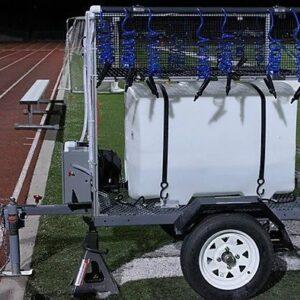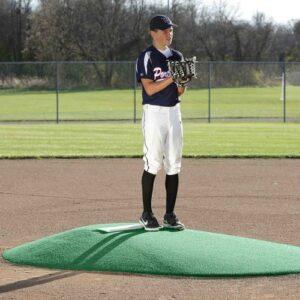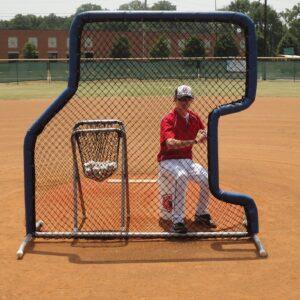- High School Max-velocity on the low side is in the low 60’s. Good for HS would be low-mid 70’s; excellent would be mid to upper 70’s.
- In the College group, the low side is 70-74; good would fall in 75-79, excellent would be 80-84, 85+ would be a serious prospect as far as velocity goes.
Ball Control & Release Efficiency
To evaluate this component, I use the following technique. I position the player in front of the black tarp that hangs behind the home plate in many batting cages. I measure out 10 feet and draw a line. It must always be 10 feet. The player puts his toes on the line facing the black screen. The coach kneels in front of the catcher, safely off-center. The player gets into his runner on base receiving position. The coach throws the “pitch.” The catcher receives the pitch and executes a full speed throw into the screen. The catcher must have the mindset that he is throwing 127 feet to 2nd and throw through the screen to get a reading that reflects his actual mechanics and quickness. The stopwatch is started when the ball hits the glove and stops when the ball hits the screen. The player must sit on the strike and not move until the ball hits his glove as if it were an 0-2 count late in the game. Because the catcher is releasing the ball about 5 feet in front of the screen, arm strength and ball velocity have little to do with the time recorded on the stopwatch. The drill gives an accurate measurement of how fast the athlete gets the ball in the air. You can also have the catcher throw directly into the fence backstop, but I find the tarp makes a more precise sound when hit, making it easier to ensure a good clocking. Average release times (times are given here in hundredths of a second) for High School players would be under .95 down to .89, good would be .88 down to .82, and excellent would be .79 and under. These are the times I would expect to find on players that have not had much specific instruction related to improving their release quickness. I have many players I train that now routinely get the ball in the air in under 7/10 of a second. The fastest release I have ever timed at any age was a 14-year old that throws in the .49-.52 range. He is now 16-years old, has grown 6 inches, added 30 lbs, and can still get the ball in the air in under 6/10 of a second.
Summary
While some critics of this evaluation process mention that it does not incorporate all the variables of a game situation, it gives a good base for comparison between players. Using these measurement techniques allows me to break the throw down into its 3 different phases and better attack the area of greatest weakness in any given playe Many college players have guns for arms and velocities out of crouch 85 MPH+ but have slower releases than several high school kids. The above evaluation technique has enabled me to isolate what section of their throw is the weakest and look for the eating time flaws. Likewise, I have some players that have lightning-fast releases but 65 MPH velocity. Again, the evaluation process helps me direct their training efforts in the area of greatest weakness.

Dave Weaver founded The New England Catching Camp in 1994 after realizing that instruction for the toughest position on the diamond was generally unavailable. Coach Weaver teaches at numerous facilities throughout New England and conducts group clinics, team workshops, coaches clinics, and private sessions with catchers of all ages. Dave has trained athletes in various sports for over 30 years and has coached catchers youth through professional levels.
Dave is also the author of the DVD A Coaches Guide To Training Catchers. Which features over 2½ hours of demonstrations & drills covering what catchers need to know about receiving, blocking, throwing, and fielding.
“Dave takes the art of catching to a level few trainers can reach during their regular season,” high school baseball coach Joe Lindley says about Weaver’s DVD. “His techniques not only teach players how to become great catchers, but they also teach catchers how to become great leaders.”
-
100 Gallon Rechargeable Football Hydration Station | Made In USA & New Low Price!$5,690.00
-
4 Row – 15′ USA Series Double Footboard Aluminum Picket Bleacher$5,400.00
-
Product on sale10″ Portable Pitching Mound | 2 Game Sizes | Made In USA QualityPrice range: $4,290.00 through $4,390.00
A catcher’s throw down to the second base is usually evaluated by determining the elapsed time from the point the pitched ball hits the catcher’s glove until the ball hits the infielder’s glove taking the throw at 2nd. This time is known as the “Pop Time.”
Much emphasis has been put on this time when evaluating High School, College, and Pro catchers. In my work with catchers, I have found that just using this one measurement does not give a complete picture of a catcher’s strengths and weaknesses related to this throw.
I have found that the throw to 2nd is in essence a 3-part skill. Each part can be evaluated for strengths and weaknesses and improved. The three components are:
- Ball Control and Release Efficiency
- In-flight Velocity
- Accuracy
On average, a professional catcher’s success rate is just 25% and, at best, around 50%. Success rates for youth catchers have as wide a success rate as well. Each of the three components of the throw contributes to the success or failure of each throw down to 2nd. Without evaluating each part and just evaluating the entire throw using Pop Time readings, coaches may overlook areas needing improvement.
The following is the three part evaluation process I use to evaluate catchers’ throws, presented in reverse order.
Accuracy is the easiest to evaluate and most observable component, irrespective of the other two parts. Rating a catcher on this portion is just a matter of noting whether the ball arrives at the target some 127 feet away. The target I instruct my catchers to throw is a spot 24 inches to the 1st base side of 2nd and 18 inches off the ground. Practice usually results in improvement unless the throwing mechanics are completely wrong. A simple observation of the act of throwing will tell you if the catcher is doing it right or wrong.
⭐ Our Featured Lineup ⭐
In-Flight Velocity
Velocity plays a big part in the results a catcher will see at the different levels of play. What is important is to see if the catcher employs a throwing technique that allows him to throw at near 100% of the maximum velocity he can generate.
To do this, I need to determine the catcher’s maximum throwing velocity using 2 different throwing techniques. The first technique I will have him throw using is whatever technique the catcher feels he can generate the absolute maximum velocity. For most of the catchers I evaluate, this is almost always an outfielder’s crow hop. I will also take readings having him throw from his runners-on crouch.
Once I get the player’s arm warmed up to game readiness, I have him make a throw from a crow hop or whatever technique he likes to generate the maximum velocity. I time that on the radar gun. then have him get into his runners-on crouch. Then throw him a pitch down the middle and have him throw down full speed.
And again time the velocity of that throw with the radar gun. I will then alternate between the 2 throwing techniques for a total of 4 throws with each technique. I will average the 4 throws in each technique group and compare those 2 averages.
After timing over 1,500 catchers this way, I have found that a drop in velocity of less than 3% from max velocity to out of crouch velocity is the goal. More of a drop than that, and there is something in that player’s mechanics of his throw to second base that is excessively “eating” velocity. At that point, a close evaluation of those mechanics is needed.
Velocities tend to be varied when I look at the database of kids I have time. When I look at the speeds for the throws out of crow hops for the different groups, I have found the following:
- High School Max-velocity on the low side is in the low 60’s. Good for HS would be low-mid 70’s; excellent would be mid to upper 70’s.
- In the College group, the low side is 70-74; good would fall in 75-79, excellent would be 80-84, 85+ would be a serious prospect as far as velocity goes.
Ball Control & Release Efficiency
To evaluate this component, I use the following technique. I position the player in front of the black tarp that hangs behind the home plate in many batting cages. I measure out 10 feet and draw a line. It must always be 10 feet. The player puts his toes on the line facing the black screen. The coach kneels in front of the catcher, safely off-center. The player gets into his runner on base receiving position. The coach throws the “pitch.” The catcher receives the pitch and executes a full speed throw into the screen. The catcher must have the mindset that he is throwing 127 feet to 2nd and throw through the screen to get a reading that reflects his actual mechanics and quickness. The stopwatch is started when the ball hits the glove and stops when the ball hits the screen. The player must sit on the strike and not move until the ball hits his glove as if it were an 0-2 count late in the game. Because the catcher is releasing the ball about 5 feet in front of the screen, arm strength and ball velocity have little to do with the time recorded on the stopwatch. The drill gives an accurate measurement of how fast the athlete gets the ball in the air. You can also have the catcher throw directly into the fence backstop, but I find the tarp makes a more precise sound when hit, making it easier to ensure a good clocking. Average release times (times are given here in hundredths of a second) for High School players would be under .95 down to .89, good would be .88 down to .82, and excellent would be .79 and under. These are the times I would expect to find on players that have not had much specific instruction related to improving their release quickness. I have many players I train that now routinely get the ball in the air in under 7/10 of a second. The fastest release I have ever timed at any age was a 14-year old that throws in the .49-.52 range. He is now 16-years old, has grown 6 inches, added 30 lbs, and can still get the ball in the air in under 6/10 of a second.
Summary
While some critics of this evaluation process mention that it does not incorporate all the variables of a game situation, it gives a good base for comparison between players. Using these measurement techniques allows me to break the throw down into its 3 different phases and better attack the area of greatest weakness in any given playe Many college players have guns for arms and velocities out of crouch 85 MPH+ but have slower releases than several high school kids. The above evaluation technique has enabled me to isolate what section of their throw is the weakest and look for the eating time flaws. Likewise, I have some players that have lightning-fast releases but 65 MPH velocity. Again, the evaluation process helps me direct their training efforts in the area of greatest weakness.

Dave Weaver founded The New England Catching Camp in 1994 after realizing that instruction for the toughest position on the diamond was generally unavailable. Coach Weaver teaches at numerous facilities throughout New England and conducts group clinics, team workshops, coaches clinics, and private sessions with catchers of all ages. Dave has trained athletes in various sports for over 30 years and has coached catchers youth through professional levels.
Dave is also the author of the DVD A Coaches Guide To Training Catchers. Which features over 2½ hours of demonstrations & drills covering what catchers need to know about receiving, blocking, throwing, and fielding.
“Dave takes the art of catching to a level few trainers can reach during their regular season,” high school baseball coach Joe Lindley says about Weaver’s DVD. “His techniques not only teach players how to become great catchers, but they also teach catchers how to become great leaders.”








